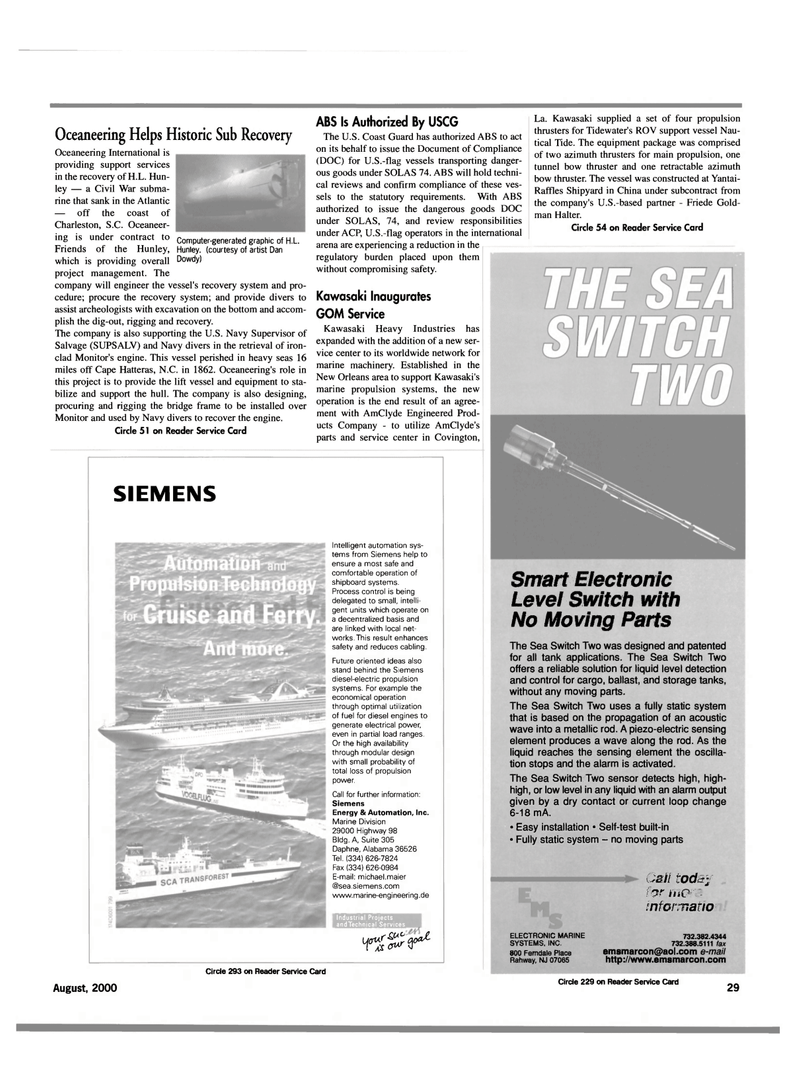
Page 29: of Maritime Reporter Magazine (August 2000)
Read this page in Pdf, Flash or Html5 edition of August 2000 Maritime Reporter Magazine
Computer-generated graphic of H.L.
Hunley. (courtesy of artist Dan
Dowdy)
Oceaneering Helps Historic Sub Recovery
Oceaneering International is providing support services in the recovery of H.L. Hun- ley — a Civil War subma- rine that sank in the Atlantic — off the coast of
Charleston, S.C. Oceaneer- ing is under contract to
Friends of the Hunley, which is providing overall project management. The company will engineer the vessel's recovery system and pro- cedure; procure the recovery system; and provide divers to assist archeologists with excavation on the bottom and accom- plish the dig-out, rigging and recovery.
The company is also supporting the U.S. Navy Supervisor of
Salvage (SUPSALV) and Navy divers in the retrieval of iron- clad Monitor's engine. This vessel perished in heavy seas 16 miles off Cape Hatteras, N.C. in 1862. Oceaneering's role in this project is to provide the lift vessel and equipment to sta- bilize and support the hull. The company is also designing, procuring and rigging the bridge frame to be installed over
Monitor and used by Navy divers to recover the engine.
Circle 51 on Reader Service Card
ABS Is Authorized By USCG
The U.S. Coast Guard has authorized ABS to act on its behalf to issue the Document of Compliance (DOC) for U.S.-flag vessels transporting danger- ous goods under SOLAS 74. ABS will hold techni- cal reviews and confirm compliance of these ves- sels to the statutory requirements. With ABS authorized to issue the dangerous goods DOC under SOLAS, 74, and review responsibilities under ACP, U.S.-flag operators in the international arena are experiencing a reduction in the regulatory burden placed upon them without compromising safety.
Kawasaki Inaugurates
GOM Service
Kawasaki Heavy Industries has expanded with the addition of a new ser- vice center to its worldwide network for marine machinery. Established in the
New Orleans area to support Kawasaki's marine propulsion systems, the new operation is the end result of an agree- ment with AmClyde Engineered Prod- ucts Company - to utilize AmClyde's parts and service center in Covington,
La. Kawasaki supplied a set of four propulsion thrusters for Tidewater's ROV support vessel Nau- tical Tide. The equipment package was comprised of two azimuth thrusters for main propulsion, one tunnel bow thruster and one retractable azimuth bow thruster. The vessel was constructed at Yantai-
Raffles Shipyard in China under subcontract from the company's U.S.-based partner - Friede Gold- man Halter.
Circle 54 on Reader Service Card
SIEMENS
Intelligent automation sys- tems from Siemens help to ensure a most safe and comfortable operation of shipboard systems.
Process control is being delegated to small, intelli- gent units which operate on a decentralized basis and are linked with local net- works. This result enhances safety and reduces cabling.
Future oriented ideas also stand behind the Siemens diesel-electric propulsion systems. For example the economical operation through optimal utilization of fuel for diesel engines to generate electrical power, even in partial load ranges.
Or the high availability through modular design with small probability of total loss of propulsion power.
Call for further information:
Siemens
Energy & Automation, Inc.
Marine Division 29000 Highway 98
Bldg. A, Suite 305
Daphne, Alabama 36526
Tel. (334) 626-7824
Fax (334) 626-0984
E-mail: michael.maier @sea. siemens.com www.marine-engineering.de
Industrial Projects andTechnical Services ri^r1
Circle 293 on Reader Service Card
Smart Electronic Level Switch with
No Mowing Parts
The Sea Switch Two was designed and patented for all tank applications. The Sea Switch Two offers a reliable solution for liquid level detection and control for cargo, ballast, and storage tanks, without any moving parts.
The Sea Switch Two uses a fully static system that is based on the propagation of an acoustic wave into a metallic rod. A piezo-electric sensing element produces a wave along the rod. As the liquid reaches the sensing element the oscilla- tion stops and the alarm is activated.
The Sea Switch Two sensor detects high, high- high, or low level in any liquid with an alarm output given by a dry contact or current loop change 6-18 mA. • Easy installation • Self-test built-in • Fully static system - no moving parts
ELECTRONIC MARINE
SYSTEMS, INC. 800 Ferndale Place
Rahway, NJ 07065
Call today for more informatioi 732.382.4344 732.388.5111 fax [email protected] e-mail http://www.emsmarcon.com
August, 2000 Circle 229 on Reader Service Card 29

 28
28

 30
30
